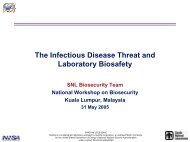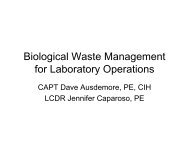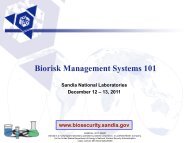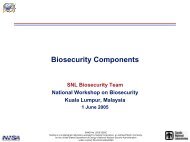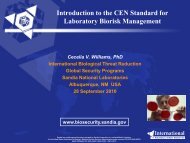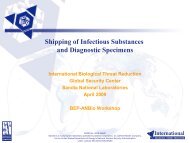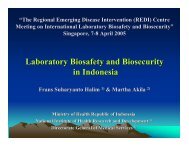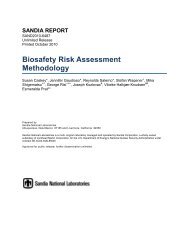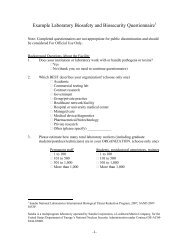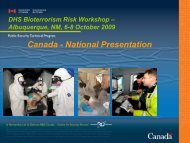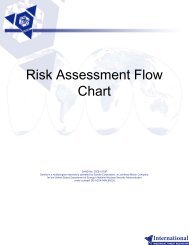Laboratory Biosafety 101 - Sandia National Laboratories
Laboratory Biosafety 101 - Sandia National Laboratories
Laboratory Biosafety 101 - Sandia National Laboratories
You also want an ePaper? Increase the reach of your titles
YUMPU automatically turns print PDFs into web optimized ePapers that Google loves.
A Focus on the <strong>Laboratory</strong>• <strong>Laboratory</strong> <strong>Biosafety</strong>• A set of preventive measures designed to reduce the riskof accidental exposure to or release of a biological agent• <strong>Laboratory</strong> Biosecurity• A set of preventive measures designed to reduce the riskof intentional removal (theft) and misuse of a biologicalagent – intent to cause harm• Fundamentally, the issue is a concern that there arerisks to working with pathogens and toxins in alaboratory setting2
Biocontainment• Biocontainment is the control of biohazards through• Practices & procedures, including administrative controls• Good lab practices• Written SOPs for research activities, specialized equipment, etc• Required training• Access requirements• Primary barriers (safety equipment)• <strong>Biosafety</strong> cabinets (BSCs)• Lab equipment (pipetting devices, waste containers, safety centrifugecups)• Personal protective equipment• Secondary barriers (engineering & architectural controls)• Building & room construction – the floor plan• HVAC issues – directional airflow, filtration• Waste treatment3
<strong>Biosafety</strong> Levels• <strong>Biosafety</strong> Levels• Four biosafety levels provide increasingdegrees of protection• What’s the right balance of practices &procedures, primary barriers and secondarybarriers?• Applications:• Labs (BSL-1, 2, 3, 4)• (Small) Animal Containment (ABSL-1, 2, 3,4)• Large Animal Containment (“BSL-3 AG”)• Plant Containment (BSL-1P, 2P, 3P, 4P)4
Planning: Risk Assessment is Critical• Identify biological agents that will be usedPractices &procedures• Perform risk assessment• Include an evaluation of settings• Labs• Animal housing• Necropsy• Other?Primarybarriers• And activities:• At the macro scale: research, diagnostics, health care, industry, other?• At the micro scale: routine manipulations, producing large volumes,aerosolization, animal testing, other?Secondarybarriers• Determine biosafety level• What degree of biocontainment is necessary to mitigate the risk?• What is the appropriate balance of practices & procedures, primarybarriers, and secondary barriers?5
<strong>Biosafety</strong> Risk Assessment:Safety Risk Groups• Risk Group 1• No or low individual and community risk• Unlikely to cause human or animal disease• Risk Group 2• Moderate individual risk, low community risk• Can cause disease but unlikely to be a serious hazard. Lab exposures may causeserious infection, but effective treatment and preventative measures are available andrisk of spread of infection is limited• Risk Group 3• High individual risk, low community risk• Usually causes serious human or animal disease but does not ordinarily spread.Effective treatment and preventative measures are available.• Risk Group 4• High individual and community risk• Usually causes serious human or animal disease and can be readily transmitted.Effective treatment and preventative measures are not usually available
Safety Risk Group Examples• Risk Group 1• Bacillus subtilis• Ubiquitous bacterium found in water,soil, air• Not considered pathogenic ortoxigenic to humans, animals, orplants• Escherichia coli K-12• E. coli is normal inhabitant of colonof almost all mammals• K-12 is debilitated strain – does notnormally colonize human intestine• History of safe commercial use• Risk Group 2• Measles virus• Pathogenicity: acute disease, fatality
Safety Risk Group Examples• Risk Group 3• Mycobacterium tuberculosis• Proven hazard to laboratory workers(3x higher rate of infection)• Low aerosol infectious dose (ID 50
Components of <strong>Laboratory</strong> <strong>Biosafety</strong>9
<strong>Biosafety</strong>: Engineering Controls• Primary barriers – contain the agent at the source• Biological safety cabinet• Animal caging• Specialized lab equipment (centrifuges, fermenters, etc.)• Secondary barriers – contain the agent within the room or facility incase an agent escapes from the primary barriers• Building & Room Construction• HVAC Issues:• Directional airflow• Exhaust filtration• Other Engineering Controls:• Solid waste treatment• Wastewater treatmentBuildingRoomBSCTubeBSC10
<strong>Biosafety</strong> Levels 1 and 2• <strong>Biosafety</strong> Level 1• Suitable for work involving well-characterized agents not known to cause disease inhealthy adult humans and of minimal potential hazard to laboratory personnel and theenvironment.• Examples:• Bacillus subtilis• Naegleria gruberi• E. coli• <strong>Biosafety</strong> Level 2• Suitable for work involving agents of moderate potential hazard to personnel and theenvironment• Examples:• Measles virus• Salmonellae species• Toxoplasma species• Hepatitis B virus11
<strong>Biosafety</strong> Levels 3 and 4• <strong>Biosafety</strong> Level 3• Suitable for work with infectious agents which may cause serious or potentially lethaldisease as a result of exposure by the inhalation route.• Examples:• Mycobacterium tuberculosis• St. Louis encephalitis virus• Coxiella burnetii• <strong>Biosafety</strong> Level 4• Suitable for work with dangerous and exotic agents that pose a high individual risk ofaerosol transmitted laboratory infections and life-threatening disease.• Examples:• Ebola Zaire virus• Rift Valley Fever virus12
<strong>Biosafety</strong> Level 1: Facility Design• Requirements:• <strong>Laboratories</strong> have doors• Sink for hand washing• Work surfaces easily cleaned• Bench tops are impervious to water• Sturdy furniture• Windows fitted with flyscreens• Other design and construction issues:• Location – not separated• Structure – normal construction• Ventilation – no special requirements13
<strong>Biosafety</strong> Level 2: Facility Design• Requirements:• <strong>Laboratories</strong> have lockable doors• Sink for hand washing• Work surfaces easily cleaned• Bench tops are impervious to water• Sturdy furniture• Biological safety cabinets installed as needed• Adequate illumination• Eyewash readily available• Windows fitted with flyscreens• Location - separated from public areas• Ventilation – directional• Air flows into lab without re-circulation to non-lab areasRestricted accesswhen work in progress15
<strong>Biosafety</strong> Level 2: Facility Design16
<strong>Biosafety</strong> Level 3: Facility Design• Requirements:• BSL-1 and 2 Requirements PLUS• Enclosures for aerosol generating equipment• Room penetrations sealed• Walls, floors and ceilings are water resistant for easy cleaning• BSC class II or III to manipulate infectious material• Separate building or isolated zone within a building• Directional inward airflow• Single-pass air; can be recirculated if HEPA filtered• Double door entry• BSCs mandatory• Additional requirements depending on work and agents:• HEPA filtration of the exhaust• Effluent decontamination• Personnel showers17
<strong>Biosafety</strong> Level 3: Facility Design18
<strong>Biosafety</strong> Level 4: Facility Design• BSL3 enhanced requirements plus:• Either:• Class III biosafety cabinet• Personnel shower required to exit room with cabinet• Or• Positive pressure suit with self-contained breathing apparatus• Suit decontamination shower• Personnel shower to exit• Double HEPA-filtered exhaust• HEPA-filtered supply air• Decontamination of all effluents• Sterilization of waste and materials• Redundant back-up systems• Pass through autoclave
<strong>Biosafety</strong> Level 4: Facility DesignSmith Carter
Standard and Special <strong>Laboratory</strong> Practices• Use of paper covering on work surface assists clean-up• Use of appropriate disinfectant• Substitute plastic for glass• Careful pipetting techniques• Wash hands• Minimize aerosol generation• Wear appropriate PPE21
Standard and Special <strong>Laboratory</strong>Practices: Safe Use of Sharps• Percutaneous exposure risk• Employ safe work practices• Only use sharps if absolutely required as part ofa process• Utilize safe sharp devices• Keep hands away from needles• Use mechanical methods for needle removal• Never bend, recap or manipulate sharps byhand.• Dispose into sharps container• Collect reusable sharps in puncture-proof,leak-proof containers22
Summary of <strong>Biosafety</strong> Level RequirementsFrom: WHO LBM 3 rd edition23



